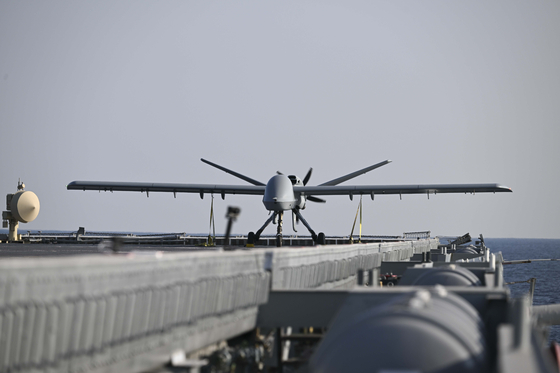A U.S. General Atomics MQ-1C Gray Eagle, an unmanned reconnaissance and attack aircraft, took off from the Korean Navy’s amphibious assault ship ROKS Dokdo off the coast of Pohang, North Gyeongsang, in the East Sea on November 12.
This marked the first combat test of a fixed-wing drone taking off from a Korean naval vessel.
The Navy has previously operated vertical takeoff and landing drones, but this was the first time it had flown a fixed-wing drone.
The Gray Eagle demonstrated the “dirty configuration,” where it slowly approaches the ground with its landing gear down, and the “clean configuration,” flying at speeds of over 185 kilometers (115 miles) per hour before moving to the Pohang takeoff site.

This combat test was in response to the decrease in military personnel and concerns that the Navy one day may have insufficient personnel to crew its ships properly. As a result, the Navy is turning its attention to introducing manned and unmanned complex systems. Additionally, as drones have become essential in recent conflicts such as the Israel-Hamas conflict and the Ukraine war, the Korean military is rushing to introduce advanced unmanned systems.
“This combat test is intended to verify the effectiveness of unmanned forces and prepare for changes in the future battlefield environment and reduction in troops,” said Yang Yong-mo, the Korean Navy’s chief of naval operations. “It is part of a plan to introduce and operate various unmanned forces early on.”
Military powers such as the United States are also shifting the weight of weapons development to strengthening uncrewed aerial vehicles (UAVs) and uncrewed surface vehicles (USVs), which are “cost-effective items” and can drastically reduce troop losses.
When the Gray Eagle took off on Tuesday from the ROKS Dokdo, only the sound of the tail propeller was faintly audible, a sharp contrast with rotary-wing drones, which are so noisy that it is impossible to converse with people nearby.
The Gray Eagle can also fly over 20 hours, which is longer than manned fighters and surveillance aircraft. The Gray Eagle is reportedly under further development to increase its operation time to 25 hours. When finished, it will be possible to conduct 24-hour surveillance of the Korean Peninsula together with the latest maritime surveillance aircraft, the P-8.
![A combat test is being held on the Korean Navy’s amphibious assault ship ROKS Dokdo off the coast of Pohang, North Gyeongsang, in the East Sea on Tuesday. [REPUBLIC OF KOREA NAVY]](https://koreajoongangdaily.joins.com/data/photo/2024/11/13/e2841176-d62b-4b19-a932-92be45175d6f.jpg)
The U.S. Forces Korea (USFK) operates the Grey Eagle, along with 12 improved Gray Eagle Extended Range drones at Camp Humphreys. U.S. Army officials also joined the combat test on Tuesday, according to the Korean military.
The Gray Eagle that the Korean Navy used for combat tests is a version that General Atomics is developing in collaboration with Hanwha Aerospace that incorporates short-takeoff and landing (STOL) capabilities. General Atomics named this version “Mojave,” after the desert in California, to emphasize that it can take off and land in harsh and barren environments.
The deck length of the ROKS Dokdo is 199 meters (653 feet), while the deck length of a typical aircraft carrier is at least 300 meters.
General Atomics conceives installing up to six Gray Eagle stalls on ROKS Dokdo. The vehicles can carry up to 16 Hellfire air-to-ground missiles. Air-to-air Stinger missiles, GBU small-diameter bombs and anti-drone weaponry were also added.
Combat testing is a procedure to check a new weapon system’s operational concept and capabilities. The Korean military examines test results before deciding to adopt a system.
Since the ROKS Dokdo was not initially designed as an aircraft carrier, it suffers limitations when operating fixed-wing drones. The Gray Eagle has a wingspan of 16 meters and a length of 9 meters, and the Dokdo has only 21 meters of deck space where the drone can glide.
For this reason, while the drone could take off from the ROKS Dokdo from a complete stop, no landing was attempted during Tuesday’s combat test. Accordingly, the Navy is also considering a ship platform capable of carrying manned and unmanned aerial power in the future.
BY LEE YOO-JUNG,LIM JEONG-WON [lim.jeongwon@joongang.co.kr]





